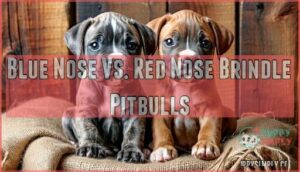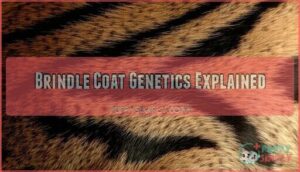This site is supported by our readers. We may earn a commission, at no cost to you, if you purchase through links.
 Beneath the sunlight, a brindle pitbull’s coat can shimmer like burnished bronze—each stripe telling a story of strength passed down through generations. There’s a quiet confidence in the way these dogs carry themselves, as if they know their reputation inspires more debate than many breeds see in a lifetime. Their distinctive tiger-striped pattern turns heads at the park, but what truly sets them apart runs far deeper than the color of their fur.
Beneath the sunlight, a brindle pitbull’s coat can shimmer like burnished bronze—each stripe telling a story of strength passed down through generations. There’s a quiet confidence in the way these dogs carry themselves, as if they know their reputation inspires more debate than many breeds see in a lifetime. Their distinctive tiger-striped pattern turns heads at the park, but what truly sets them apart runs far deeper than the color of their fur.
Living alongside a brindle pitbull means embracing a loyal companion shaped by history, genetics, and a resilience that endures. Understanding what makes these dogs unique helps build the foundation for a lasting bond.
Table Of Contents
- Key Takeaways
- What is a Brindle Pitbull?
- Brindle Pitbull Origins and History
- Brindle Pitbull Appearance and Size
- Brindle Coat Genetics Explained
- Are Brindle Pitbulls Rare?
- Brindle Pitbull Temperament and Personality
- Health Issues and Lifespan of Brindle Pitbulls
- Caring for a Brindle Pitbull
- Training and Socialization Tips
- Pros and Cons of Brindle Pitbull Ownership
- Frequently Asked Questions (FAQs)
- Conclusion
Key Takeaways
- Brindle Pitbulls are not a separate breed but a color variation known for their unique tiger-striped coats, which result from specific genetic factors.
- Temperament, health, and trainability in Brindle Pitbulls match those of other Pitbulls; their reputation and behavior rely on responsible ownership and proper socialization, not coat color.
- These dogs require regular exercise, mental stimulation, and grooming, with typical health needs including allergy management and joint care to support a lifespan of 10 to 16 years.
- Brindle Pitbulls face stereotypes and breed stigma, but with early training and care, they can be affectionate, loyal family companions adaptable to various living situations.
What is a Brindle Pitbull?
A Brindle Pitbull isn’t a separate breed—it’s simply a color variation found in American Pit Bull Terriers and American Staffordshire Terriers. While these dogs share the same loyal and energetic personality as any Pitbull, their distinctive striped coat often raises questions about how they differ from other types.
Let’s clear up what makes Brindle Pitbulls unique and address some common myths that surround them.
Brindle Pitbull Vs. Other Pitbull Types
While all Pitbulls share the same core breed characteristics, the brindle variety stands out purely for its striking coat pattern—not because it’s a different type of dog.
No matter what color their coat is, Pitbulls don’t show differences in temperament or health because of it. Whether you’re looking at a blue nose, red nose, or brindle, all Pitbulls meet the same breed standards and respond similarly to training—the real difference is just how they look.
Common Misconceptions About Brindle Pitbulls
Despite their unique coat, brindle Pitbulls face the same unfair stereotypes that have followed the entire breed for decades—but separating fact from fiction can help you see these dogs for who they really are.
Media portrayal and bite statistics often paint Pitbull temperament and personality inaccurately. In reality, aggression stems from poor training, not genetics.
With responsible pet ownership and proper socialization, your brindle Pitbull can be a family-friendly companion—breed bans overlook individual dog behavior entirely.
Brindle Pitbull Origins and History
Understanding where your brindle Pitbull comes from helps you appreciate what makes this dog tick. The breed’s history explains why these dogs are built the way they are and why they behave the way they do.
Let’s look at how the breed developed and what jobs these dogs originally performed.
Development of The Breed
During the early 1800s in the United Kingdom, breeders crossed Old English Bulldogs with Terriers to create the foundation for your Brindle Pitbull. Understanding this breed’s development involves recognizing these key milestones:
- Early crossbreeding produced bull-and-terrier dogs with strength and agility
- Temperament selection culled human-aggressive dogs, prioritizing gentle disposition
- Registry milestones began in 1898 when the United Kennel Club recognized the American Pitbull Terrier
- Brindle genetics emerged through the dominant Kbr allele at the K-Locus
- Modern breeding uses genetic testing to maintain desirable traits in the Pitbull breed.
Pit Bulls are known for their innate loyalty and eagerness to please. This selective approach shaped canine genetics and established breeding standards that define today’s American Pitbull Terrier.
Historical Roles and Uses
Your Brindle Pitbull’s ancestors didn’t start out as family companions—these dogs worked dangerous jobs that few other breeds could manage. From the 1800s through the early 1900s, Pitbulls served multiple roles across two continents.
| Historical Period | Primary Role | Location |
|---|---|---|
| Early 1800s | Bull-baiting sports | United Kingdom |
| Mid-1800s | Fighting pit origins | UK and early America |
| Late 1800s | Cattle herding | American farms |
| Early 1900s | American farmhands | Rural United States |
| Post-1976 | Family guardians | Domestic households |
After blood sports ended in 1976, the American Pitbull Terrier and American Staffordshire Terrier transitioned from working dogs to beloved companions. Today’s Pitbulls retain that work ethic but channel it into protecting families rather than performing dangerous tasks.
Brindle Pitbull Appearance and Size
When you picture a Brindle Pitbull, you’re looking at a dog that’s built like an athlete with a coat that tells its own story. These dogs have a signature striped pattern that sets them apart from other color variations, and their physical build reflects generations of careful breeding.
Let’s break down what makes their appearance so distinctive and what size expectations you should have.
Distinctive Brindle Coat Pattern
The striped pattern you’ll see on a Brindle Pitbull resembles tiger stripes or the grain in polished wood, with darker lines weaving through a lighter base coat in a truly eye-catching display.
Every brindle Pitbull sports a pattern that’s all its own—some coats feature bold, dramatic stripes, while others are marked by faint, fine lines.
How vivid those stripes appear depends mainly on genetics and other color intensity factors, so each dog’s look is genuinely one of a kind.
Blue Nose Vs. Red Nose Brindle Pitbulls
When you look at a Brindle Pitbull’s nose, you’ll notice it comes in two main color variations—blue or red—and this feature tells you something important about the dog’s genetic makeup and overall pigmentation.
Nose Color Genetics determines these distinct looks:
- Blue nose Brindle Pitbulls have a gray-toned nose with matching coat dilution, caused by recessive genes affecting pigment production.
- Red nose variations display a copper-colored nose with warmer coat tones, inherited through different genetic pathways.
- Temperament differences between nose colors don’t exist—behavior depends on training and socialization, not pigmentation.
- Health predispositions can vary slightly, with blue nose dogs sometimes showing increased skin sensitivity.
No matter the nose color, both types of Pitbulls are bred under the same guidelines and tend to share similar popularity with dog lovers.
Size and Weight Expectations
Most adult Brindle Pitbulls stand between 17 and 21 inches tall at the shoulder and usually weigh anywhere from 30 to 60 pounds, depending on their sex, genetics, and overall build. Males usually outweigh females by 5 to 10 pounds, showing clear gender size differences.
Growth rate factors like nutrition and exercise influence your dog’s development during the first 18 months. Use puppy weight charts to track progress and maintain ideal body condition throughout your Brindle Pitbull’s life.
Brindle Coat Genetics Explained
The brindle pattern you see on your Pitbull’s coat isn’t random—it’s the result of specific genetic factors at work.
Understanding what creates this distinctive striping can help you appreciate your dog’s unique appearance and predict what colors future litters might produce.
Let’s look at the genetics behind brindle coloring and some of the rarer variations you might encounter.
What Causes Brindle Coloring?
Ever wonder how striping appears on your Pitbull’s coat? Brindle coloring stems from K locus genes, specifically the kbr allele interacting with modifier genes to create alternating eumelanin expression. This produces the distinctive striped pattern through a process called mosaicism effects, where dark and light pigments form bands across the coat.
Here’s what determines your Brindle Pitbull’s unique appearance:
- Brindle inheritance requires specific allele combinations (kbr/kbr or kbr/ky) to express visible striping
- Eumelanin expression creates the dark stripes against lighter phaeomelanin base colors
- Modifier genes influence stripe width, intensity, and distribution patterns
Understanding canine genetics and breeding helps explain why no two brindle coats look identical. These dogs often exhibit distinctive lines or streaks on their coats.
Reverse Brindle and Rare Variations
Some Brindle Pitbulls flip the script entirely, showcasing light stripes on a predominantly dark coat. This reverse brindle pattern arises from specific genetic combinations that enhance eumelanin distribution.
Rare brindle variations include phantom brindle, which features subtle masking effects, and brindle masking, where striping is concealed beneath solid coloring. While merle brindle appears in other breeds, responsible canine genetics and breeding practices discourage this combination in Pitbulls due to associated health risks.
Are Brindle Pitbulls Rare?
You might wonder if brindle Pitbulls are hard to find compared to other coat colors. The answer depends on how common the brindle gene is in breeding populations and what breeders prioritize.
Let’s look at what makes this coloring more or less available.
Prevalence of Brindle Coloring
Brindle genetics produce one of the most recognizable coat patterns in Pitbulls, but you might be surprised to learn they’re far from rare. Brindle is the second most common Pitbull coloration after black, appearing in approximately 20-25% of the population according to breed research and registry data. Surveys of dog owners and breeders show that 18-22% of registered Pitbulls display this distinctive striped pattern.
Brindle dog breeds showcase a wide range of patterns, from barely-there stripes to bold, eye-catching designs.
Since 2015, adoption rates for brindle Pitbulls have jumped by 14%, a clear sign that more people are drawn to their striking looks. Notably, around 26% of breeders now actively aim for this distinctive coat, driven by rising demand.
While color distribution varies slightly by region, brindle coats remain widely available across North America and Europe.
Factors Affecting Rarity
Several breeding decisions and genetic factors determine whether a particular brindle pattern becomes harder to find in the Pitbull population. Breeding practices directly influence color dominance—breeders who prioritize specific Pitbull colors may reduce genetic diversity within their lines.
Geographic location plays a role too, as regional preferences affect breeder demand for certain brindle coat variations. When breeders focus heavily on trendy colors like blue nose variants, traditional brindle Pitbull patterns can become less common in those areas.
While there’s plenty of genetic variety in the Pitbull breed to keep standard brindle coats easy to find, getting those striking reverse brindles usually takes more targeted breeding and a stronger grasp of genetics.
Brindle Pitbull Temperament and Personality
Understanding your Brindle Pitbull’s temperament helps you build a strong relationship and address any concerns about their behavior.
These dogs have specific personality traits that shape how they interact with your family and others.
Let’s look at what makes their temperament unique and what you can expect from this distinctive breed.
Typical Behavior Traits
Your brindle Pitbull’s personality is shaped by both genetics and the environment you create, with most exhibiting a surprisingly gentle and affectionate nature that contradicts their tough exterior. Here’s what you can commonly expect:
- High energy requirements mean your Pitbull breed thrives with daily vigorous exercise and mental challenges
- Strong affection display shows through constant companionship seeking and physical closeness with family members
- Impressive trainability factors make canine behavior modification easier when you use positive reinforcement consistently
Their protective instincts emerge naturally, but playfulness levels remain high throughout adulthood.
Are Brindle Pitbulls Good With Kids?
When parents ask me about Pitbulls around children, I tell them the breed’s reputation doesn’t match reality—these dogs often form exceptionally strong bonds with kids when properly socialized. Your brindle Pitbull can become a protective guardian, but supervised playtime remains essential. Training children in proper canine behavior creates mutual respect.
| Safety Factor | Your Responsibility |
|---|---|
| Age Considerations | Children under 6 need constant supervision during dog interactions |
| Child-Proofing Home | Create separate spaces where your Pitbull dog can retreat when overwhelmed |
| Temperament Testing | Evaluate your brindle Pitbull’s comfort level around energetic movements |
| Responsible Pet Care | Teach kids gentle handling through structured dog training sessions |
Socialization and Aggression Myths
The media loves to paint Pitbulls as ticking time bombs, but decades of behavioral research tell a different story—aggression stems from poor socialization, not genetics.
Helping your Brindle Pitbull become a loving family member starts with socializing them early and committing to responsible ownership.
By challenging breed stereotypes and learning what really sparks aggression, you’ll find that positive training and an understanding of animal behavior can make all the difference.
Health Issues and Lifespan of Brindle Pitbulls
Every dog has its own set of health needs, and brindle Pitbulls are no different. If you want to help your companion stay strong and happy, it helps to know what to watch for.
Here’s what you should keep in mind about their health and longevity.
Common Health Concerns
Worried about dog health? You’re not alone—it’s a tightrope all pet owners walk. Brindle Pitbulls face real challenges in animal health and wellness, including:
- Allergy susceptibility and chronic skin irritations.
- Joint disorders like hip dysplasia and ligament injuries.
- Thyroid issues causing sluggishness or hair loss.
- Cancer risks, especially with skin tumors.
Stay alert for these dog care and health signals.
Lifespan and Longevity Factors
With every wag, a Brindle Pitbull’s lifespan—usually 10 to 16 years—reflects a blend of Genetic Predisposition, consistent Veterinary Care, and smart dog care and health practices. Want a healthy companion? Keep Exercise Needs met, focus on a balanced Dietary Impact, and protect from Environmental Stressors. Small choices stack up for better animal health and dog health outcomes.
| Lifespan Factors | Example Action |
|---|---|
| Dietary Impact | Choose high-protein foods |
| Veterinary Care | Schedule annual checkups |
Caring for a Brindle Pitbull
Caring for a Brindle Pitbull goes beyond providing food and shelter. These dogs need more than just the basics to truly thrive.
Here’s what you should know to keep yours happy and healthy.
Exercise and Mental Stimulation Needs
Ever notice how a dog with energy to burn can seem like a tornado in sneakers? Brindle Pitbulls thrive on daily exercise, training games, and breed-specific activities.
Use puzzle toys to provide mental stimulation and keep their minds sharp.
Social time isn’t just a nice-to-have—it’s absolutely vital. Dogs that get plenty of exercise and play are healthier overall and far less likely to develop behavior issues down the road.
Grooming and Coat Maintenance
Keeping a sleek, shiny coat on this breed is easier than you might think—all it takes is a few simple habits and a little routine care. Weekly coat brushing helps shed loose fur and aids skin health.
Limit bath frequency to every month or two. Regular nail trimming remains essential for overall dog care and health, rounding out Brindle Pitbull grooming.
Dietary Requirements
Giving your Pitbull the right start to a strong, healthy life means serving up a well-balanced diet with every meal.
As your pup grows older, make sure to adjust their calorie needs—what works for an energetic puppy won’t be the same for a laid-back senior.
Keeping an eye on their weight is key at every stage.
Some Brindle Pitbulls experience Food Allergies, so monitor for changes. Thoughtful pet care and canine nutrition protect both dog health and wellness.
Training and Socialization Tips
Training and socialization shape your Brindle Pitbull’s behavior from day one. If you’re ready for practical steps that work, you’re in the right spot.
Here’s what to focus on next.
Best Practices for Obedience Training
Teaching a dog to listen well is a lot like planting seeds—start early, use patience, and you’ll watch those good habits take root and grow. To help your Brindle Pitbull succeed, try these tactics:
- Make Positive Reinforcement part of every session
- Remember: Consistency Matters
- Keep Command Training brief but daily
- Build Socialization Skills early
- Redirect Problem Behaviors calmly
Preventing Behavioral Problems
Training your dog is a lot like teaching new tricks—you’ll get the best results if you’re proactive and really understand what drives your pup.
Using positive reinforcement goes a long way, and regular socialization rests on some tried-and-true ideas from canine psychology.
Blending a bit of behavioral modification with thoughtful training methods can help your Pitbull reach their full potential.
| Training Tip | Why It Matters | When to Use |
|---|---|---|
| Early Socialization | Avoids fear, builds trust | Puppyhood, new situations |
| Consistent Commands | Clarity for your dog | Every training session |
| Redirect, Don’t Punish | Builds good habits | At the first sign of unwanted behavior |
Pros and Cons of Brindle Pitbull Ownership
Thinking about bringing a Brindle Pitbull into your life comes with both rewards and challenges. It’s important to know what to expect before making that commitment.
Here’s what you should weigh as you consider if this breed fits your home.
Benefits of Having a Brindle Pitbull
It’s easy to see why so many people find themselves drawn to the loyal, loving nature of a Brindle Pitbull. As loyal companions, they form strong bonds, bringing warmth and security to any home.
Brindle Pitbulls fit active lifestyles, excelling in training and rewarding those who invest in their care. For many, their breed loyalty transforms pet ownership into genuine family.
Challenges and Considerations
As rewarding as life with a Brindle Pitbull can be, there are a few hurdles and honest realities you should be ready to face. You’ll encounter Training Challenges and stubborn moments, Breed Stigma in your community, and higher Ownership Costs for responsible pet care.
While aggressive behavior can be avoided with the right approach, socializing your dog takes daily effort.
True animal welfare means fully committing to every aspect of what it means to own this breed.
Is a Brindle Pitbull Right for You?
Wondering if a Brindle Pitbull belongs in your life means looking honestly at both your routines and your heart—let’s see if this loyal companion matches your world. Consider:
- How do your Family Dynamics fit with an energetic breed?
- Are Pet Compatibility and other animals a concern?
- Does your Lifestyle Assessment support daily exercise?
- Can you commit to all Ownership Responsibilities of pet care and welfare?
Frequently Asked Questions (FAQs)
How much does a Brindle Pitbull puppy cost?
Puppy Prices vary widely, with Breeder Fees ranging from $500 to $2, Adoption Costs can be lower, usually $100–$
Purchase Factors include health, lineage, and region.
Ownership Expenses add value over time in dog breeding decisions.
Are Brindle Pitbulls allowed in apartment living?
Much like living in a studio apartment with a big couch, apartment living is possible if you meet the Pitbull dog’s space requirements, manage noise levels, and give plenty of exercise—pet ownership and responsibility are essential for urban homes.
Do Brindle Pitbulls get along with cats?
If properly socialized and supervised, Pitbulls can live peacefully with cats.
Cat Introduction Tips stress patience and gradual exposure, as Pet Harmony relies on positive Feline Canine Relations to support smooth Household Dynamics and healthy Animal Coexistence.
What activities are best for Brindle Pitbulls?
Lively as a river after rain, these dogs thrive with Exercise Routines—think Agility Training, Dog Hiking, Play Therapy, and Canine Sports.
Engaging activities support mental health and build the strong bonds essential for Pitbull dog wellbeing.
Can Brindle Pitbulls be left alone during the day?
Most dogs can manage short alone time, but this breed’s strong bonds make them prone to Dog Separation Anxiety.
Focus on keeping your dog engaged with activities that prevent boredom and provide mental stimulation. These routines help meet daily exercise needs and encourage positive behavior and effective training.
Conclusion
It’s no accident that, just as their stripes intersect in surprising ways, a brindle pitbull’s life can cross paths with yours when you most need loyalty, courage, or a change of perspective.
In every unique pattern, you’ll find the echo of old strength and the beginning of new bonds.
Trust the journey you share: these companions teach patience, invite steadfast love, and return it—tail wagging, eyes bright—without ever asking you to be anything but yourself.
A brindle pitbull’s loyalty and love transform every journey together into an invitation to be your truest self

















